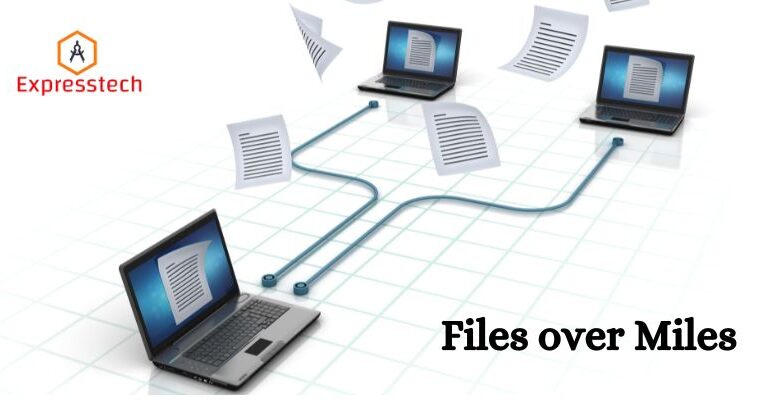How Files over Miles Work- Detail Alternative in 2024

Files over Miles was a popular service introduced back in 2010 that provided P2P file sharing between two computer systems over the internet connection. Distance was never a limitation with files over miles as this was one of the pioneers of cloud-based file-sharing systems that allowed you to conveniently pass over any type of file format over the internet.
Files Over Miles online service was discontinued over the years after the influence of new-age drives and file-sharing methods like Google Drive and One Drive. This method of file sharing was highly secure with peer-to-peer encryption, provided firewall traversal, and direct file sharing of any format.
But the question that pops into mind is why this service was discontinued if it was so reliable and convenient. In this article, we are going to explain how Files Over Miles worked and what types of features were unique to this service a decade ago.
Here’s how Files Over Miles worked:
The working mechanism of Files Over Miles was unique and easily understandable. It shared files in a few very simple steps. Here are the details of these steps:
Step 1 – The Utilization of P2P Technology:
Files Over Miles utilized the peer-to-peer (P2P) capabilities introduced in Adobe Flash Player 10. This enabled direct communication between the sender and receiver’s browsers, eliminating the need for uploading the file to a central server.
Step 2 – Encryption of files:
The service offered 128-bit AES encryption to ensure the security of the transferred data during the process.
Step 3 – Firewall Traversal:
It employed UDP hole-punching techniques to overcome potential firewall restrictions and establish a connection between the browsers.
Detailed Features of Files Over Miles:
Files Over Miles was known for offering some very useful features. Here’s a breakdown of these features.
Core Functionality:
- Direct Browser-to-Browser File Transfer: Bypassed intermediate servers for direct communication between sender and receiver browsers.
- Large File Support: Enabled sharing of files exceeding typical email attachment limitations.
Technical Aspects:
- P2P Technology: Leveraged peer-to-peer (P2P) capabilities of Adobe Flash Player 10 for direct communication.
- Encryption: Employed 128-bit AES encryption for secure data transfer.
- Firewall Traversal: Used UDP hole-punching techniques to overcome potential firewall restrictions.
Additional Features:
- Web-based Interface: Accessible through any web browser with Flash Player 10 installed.
- Cross-Platform Compatibility: Worked on various operating systems with compatible browsers.
- Progress Tracking: Provided visual feedback on the file transfer progress.
- File Resumable Downloads: Allowed resuming interrupted downloads in case of connection issues.
What Were the Limitations of Files Over Miles?
Despite being one of the most convenient platforms for sharing files, Files Over Miles had some limitations also. Here are their details.
- Reliance on Flash Player: Functionality depended on Flash Player, which is now deprecated and no longer supported.
- RAM Limitations: Maximum file size transferable was limited by the sender’s available RAM.
- Firewall Dependence: Relied on successful UDP hole punching to bypass firewalls, which could hinder functionality in some cases.
- Beta Status: The service was in beta testing and never reached widespread adoption before being discontinued.
Why FilesOverMiles Doesn’t Exist Anymore
Adobe Flash Deprecation: Adobe Flash is no longer supported, and modern browsers have removed it. FilesOverMiles relied heavily on Flash. Since FilesOverMiles has gone the way of the dinosaurs, here’s a breakdown of popular modern alternatives.
There are a few key reasons FilesOverMiles no longer exists:
- Dependence on Adobe Flash: FilesOverMiles relied heavily on Adobe Flash Player 10 for its core peer-to-peer functionality. Adobe Flash has been completely phased out due to security vulnerabilities and performance issues. Major browsers no longer support it.
- Shift Towards Cloud Storage: Cloud storage solutions like Dropbox, Google Drive, and OneDrive became incredibly popular. They offer convenient storage, easy file-sharing features, and cross-device access – things FilesOverMiles couldn’t provide as a purely browser-based solution.
- Security Evolution: File-sharing services have placed greater emphasis on security in recent years. While FilesOverMiles offered encryption, modern services integrate more robust security features including end-to-end encryption and stricter data protection policies.
- Potentially Unsustainable Business Model: FilesOverMiles likely wasn’t generating enough revenue to adapt to newer technologies and security standards.
Here are some of the popular alternatives to Files Over Miles that you can use in the modern-day era for transferring files from one computer to another over Internet services.
Cloud Storage Services:
Google Drive:
- Pros: Generous free storage space, excellent integration with Google’s suite of apps (Docs, Sheets, etc.), and real-time collaboration features.
- Cons: Can get expensive for larger storage plans.
Dropbox:
- Pros: Extremely reliable, fast file syncing, good for both personal and business use. “Smart Sync” helps save local storage space.
- Cons: The free version is very limited, and paid plans can be pricey.
OneDrive:
- Pros: Deep integration with Microsoft Windows and Office 365, a good option if you already use Microsoft products extensively.
- Cons: Can sometimes be slower than competitors, interface not as intuitive for some users.
File Transfer Services:
WeTransfer:
- Pros: Simple to use, no account needed for basic transfers, can send large files (up to 2GB for free).
- Cons: The free version limits file size and adds expiry dates. The paid version unlocks larger file limits and storage.
TransferNow:
- Pros: Easy to use, allows sending larger files for free than WeTransfer (up to 5GB on the free plan).
- Cons: Can have slower upload speeds compared to some competitors.
Specialized Peer-to-Peer (P2P) Solutions
Resilio Sync:
- Pros: Direct peer-to-peer (like FilesOverMiles), excellent for syncing large amounts of data, high-level of control over transfers, no central server involved.
- Cons: Less user-friendly than cloud-based options, setup can be more technical.
Choosing the Right Alternative:
Consider these factors to make your decision:
- File sizes: How large are the files you usually share?
- Frequency: Are you sharing files occasionally or all the time?
- Collaboration: Do you need to work on files with others, or is it primarily just sending them?
- Security: How important is encryption and control over your data?
- Budget: How much are you willing to pay, if anything?
Conclusion
Files Over Miles was a great file-sharing service that provided reliable cloud storage as well, all from the source of the internet. This online service was more like a bridge between two computer systems that made the encrypted data transmission possible over the internet. But with the advancement of technology, there are better alternatives like Google Drive, One Drive, and many more, as we mentioned in this article. Hopefully, this article has provided you with a brief overview of reliable cloud-based file-sharing services.





